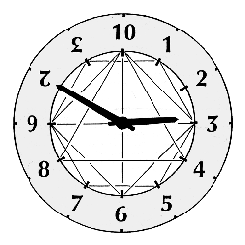



 |
 |
 |
 |
 |
Timely thoughts... |
For thousands of years the passage of time has been measured by movement. The tracking of the sun, moon and stars, the shadow on the sundial, the dripping of water in the water-clock, the sand in the glass, the shrinking calibrated candle, the clicking of cogwheels - all use movement and measurement to record the passing of time. Every growing child can see time passing in the movement of natural forces and man-made devices.
The classroom clock is an invaluable visual aid at many levels.
The passing of an hour can be seen in a complete rotation of the minute hand on a watch or clock face; a minute, by that of the seconds hand. Telling the time is learnt naturally as the relative positions of the hands are recognized at key points in a child's day. And, what is also very important, the divisions of the hour can be seen and appreciated as parts of that whole and used to demonstrate simple fractions and the arithmetic of simple fractions.
The clock face provides a visual stimulus that digits alone cannot.
When starting fractions the child already knows the meaning of 1/2 and 1/4 from the positions when people say 'half past two' or 'a quarter to one." The child can also see that a half is made up of two quarters, and can add a third quarter to obtain the fraction three-quarters; one-third can be visualised as "twenty past" the hour, or 4 twelfths (looking at the 4 on the dial). From there the teacher can use the clock-face to add fractions in a form easily assimilated by the child. Using the clock face we can show equivalence in fractions; three twelfths are equal to a quarter, the ten minutes (two twelfths) are equal to one-sixth. In passing it is worth noting that one of the most useful visual aids for presenting statistical information is the circular "pie chart".
We can also show ratio by the relative speeds and distances travelled by the hands: twelve times round by the minute hand for each revolution of the hour hand, and at half-past, the hour hand is halfway between the hour marks.
The clock face is ideal for elementary angle work.
Some people will tell us that the calculator has made all that redundant; but to reject the traditional divisions (of the hour, minute and second each into sixtieths, with their abundance of aliquot parts) and put in their place the clumsiness of decimals is to reject the commonsense units devised by practical men who knew what was useful - including that most useful unit of marine navigation, the minute of arc of latitude which equals the nautical mile, connected with, we may add, units of great antiquity.
A dozenal system for measuring time will preserve all the familiar angles and landmarks, the only difference being that an hour would be divided into *100 (one gross) parts instead of into sixty.
Of course we are told that fractions are old-fashioned and out of date; so much so that this computer keyboard, unlike my typewriter, does not include even the fraction one-half, let alone the quarter, three-quarters and eighths mine had or the thirds that German keyboards used to have. Calculate 0·25 x 400; or calculate a quarter of 400; the second calculation is quicker and easier because it is phrased in a natural manner. If you understand fractions you can be quick at making estimates to answers to calculations.
Many people have grown so accustomed to using calculators that they find it difficult to "do sums". Calculators are fine as long as you think about the answer you are looking for; you do the thinking and let the machine do the work - fine; but in the end the machine answer is often taken as correct, even when the wrong buttons have been pressed...
Time to rethink our fractions - and our arithmetic teaching. Time to return to those visual aids which have proved so useful and are so much more natural to use than a succession of ugly digital figures on a grey background....
It's not just the children who lose out.
If you have nothing but digital clocks and watches in the classroom then you lose a most valuable teaching aid. You lose out in the "grown-up" world too. Suppose you're standing in the great hall of a station, and can see a clock - however far off - you can tell the time by the position of the hands without being able to see any of the digits on the clock-face. If the clock is a digital display, on the other hand, you will, usually, have to move a lot nearer to it to be able to see what it says. The traditional clock face is easier to read and more convenient... and since it isn't broke, why insist on fixing it by replacing it with what is imagined to be an improvement? I believe in making life easier for humans.